Analysis of Professional Conduct of Nurses According to NMBA
VerifiedAdded on 2020/03/16
|9
|2463
|58
Essay
AI Summary
This essay analyzes a case study involving a nurse, Ms. Heather Conyard, accused of unsatisfactory professional conduct, specifically addressing breaches of the NMBA professional code of conduct. The analysis highlights the nurse's failure to recognize the severity of a patient's condition, leading to a fatal outcome. The essay examines immediate actions the nurse could have taken to improve the patient's care, including timely communication with doctors and adherence to hospital policies. It details specific NMBA standards breached, such as providing safe care, familiarity with relevant laws, and making sound clinical decisions. The essay emphasizes the importance of professional accountability, nurse-patient interaction, and clinical judgment. The author, a student nurse, reflects on the case, emphasizing the importance of preparedness, coordination with colleagues, proper documentation, and understanding the "Between the Flag" policy to ensure patient safety. The conclusion reiterates the critical role of nurses in providing optimal medical attention and care, and the consequences of unsatisfactory professional conduct.
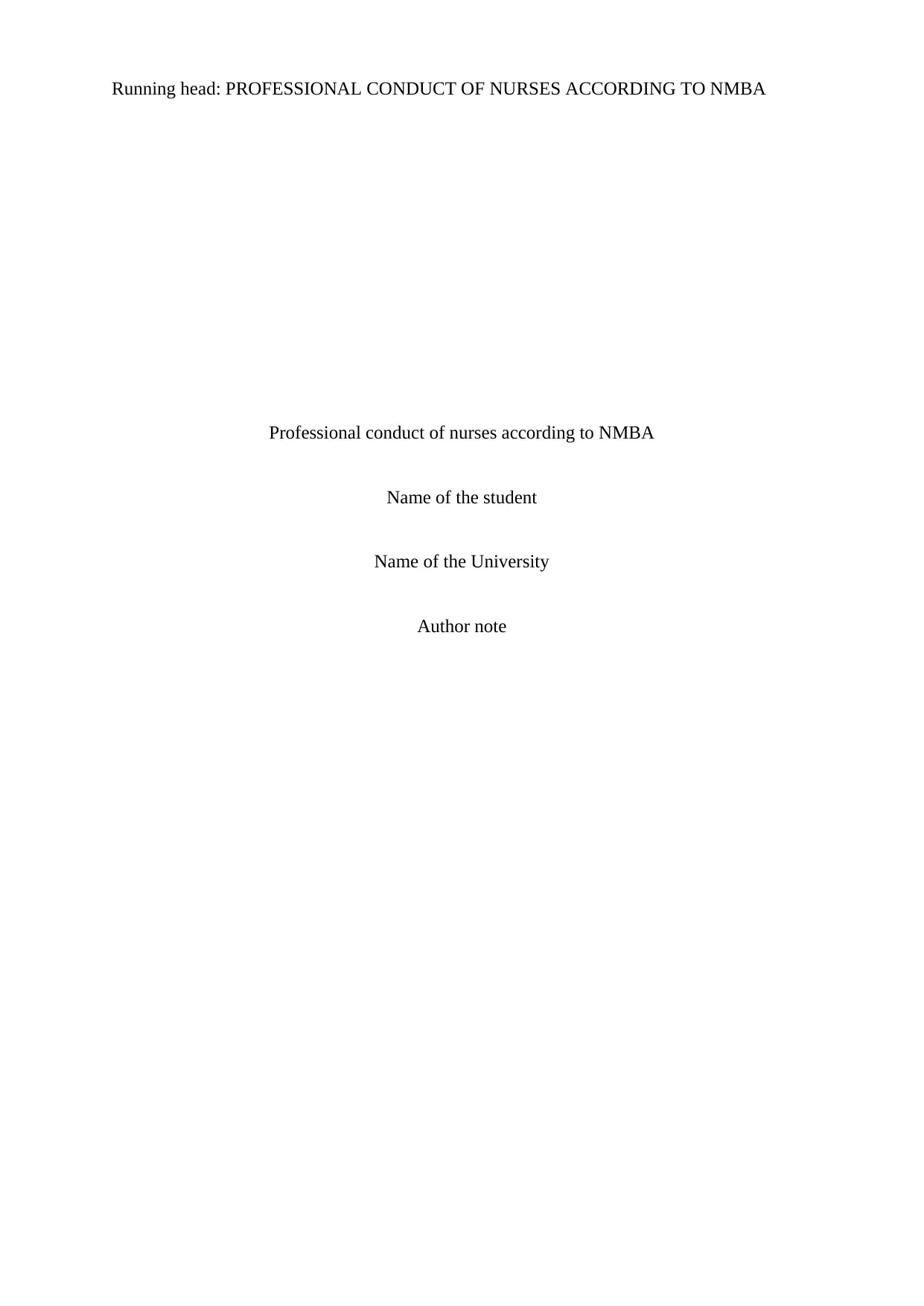
Running head: PROFESSIONAL CONDUCT OF NURSES ACCORDING TO NMBA
Professional conduct of nurses according to NMBA
Name of the student
Name of the University
Author note
Professional conduct of nurses according to NMBA
Name of the student
Name of the University
Author note
Paraphrase This Document
Need a fresh take? Get an instant paraphrase of this document with our AI Paraphraser
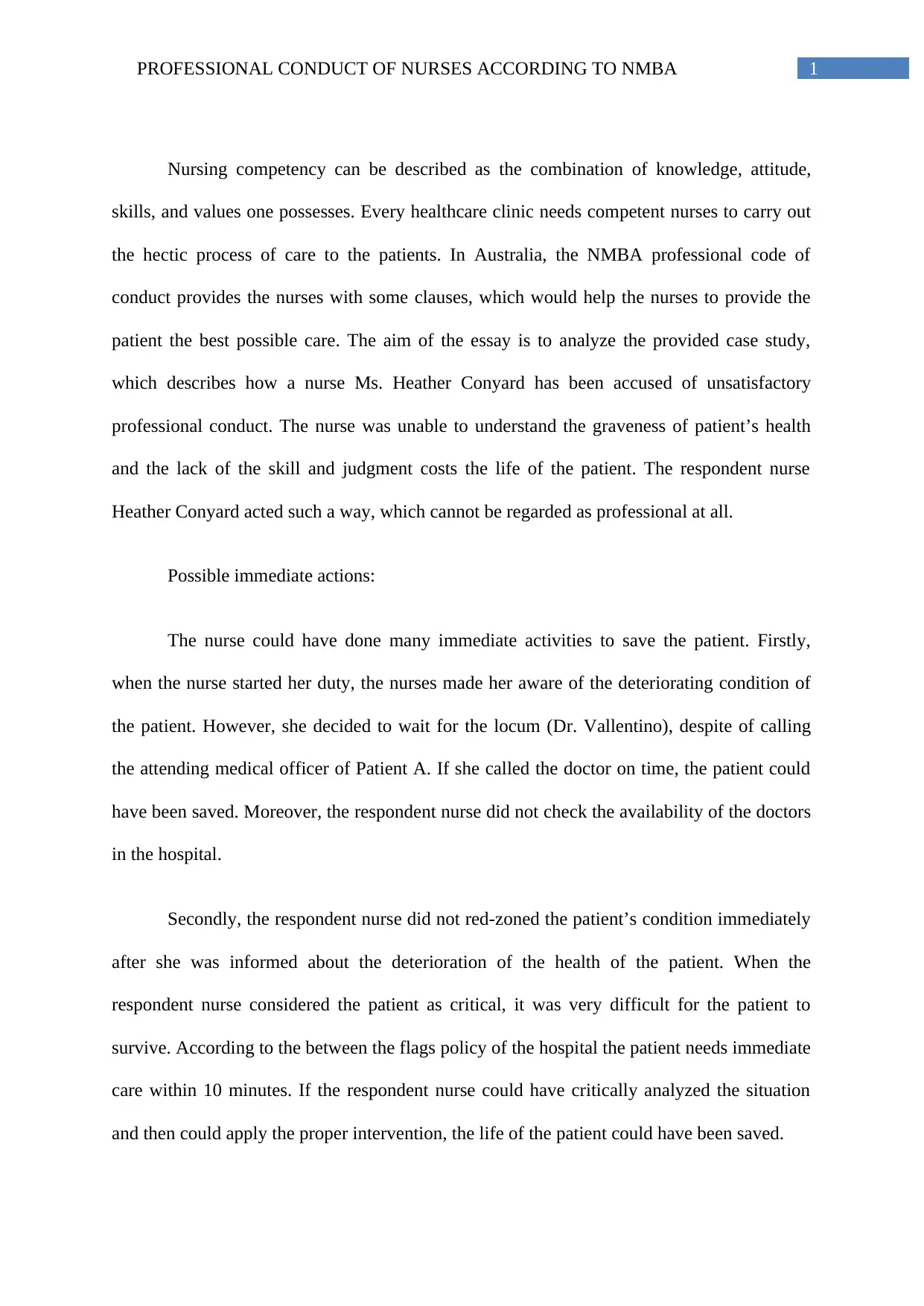
1PROFESSIONAL CONDUCT OF NURSES ACCORDING TO NMBA
Nursing competency can be described as the combination of knowledge, attitude,
skills, and values one possesses. Every healthcare clinic needs competent nurses to carry out
the hectic process of care to the patients. In Australia, the NMBA professional code of
conduct provides the nurses with some clauses, which would help the nurses to provide the
patient the best possible care. The aim of the essay is to analyze the provided case study,
which describes how a nurse Ms. Heather Conyard has been accused of unsatisfactory
professional conduct. The nurse was unable to understand the graveness of patient’s health
and the lack of the skill and judgment costs the life of the patient. The respondent nurse
Heather Conyard acted such a way, which cannot be regarded as professional at all.
Possible immediate actions:
The nurse could have done many immediate activities to save the patient. Firstly,
when the nurse started her duty, the nurses made her aware of the deteriorating condition of
the patient. However, she decided to wait for the locum (Dr. Vallentino), despite of calling
the attending medical officer of Patient A. If she called the doctor on time, the patient could
have been saved. Moreover, the respondent nurse did not check the availability of the doctors
in the hospital.
Secondly, the respondent nurse did not red-zoned the patient’s condition immediately
after she was informed about the deterioration of the health of the patient. When the
respondent nurse considered the patient as critical, it was very difficult for the patient to
survive. According to the between the flags policy of the hospital the patient needs immediate
care within 10 minutes. If the respondent nurse could have critically analyzed the situation
and then could apply the proper intervention, the life of the patient could have been saved.
Nursing competency can be described as the combination of knowledge, attitude,
skills, and values one possesses. Every healthcare clinic needs competent nurses to carry out
the hectic process of care to the patients. In Australia, the NMBA professional code of
conduct provides the nurses with some clauses, which would help the nurses to provide the
patient the best possible care. The aim of the essay is to analyze the provided case study,
which describes how a nurse Ms. Heather Conyard has been accused of unsatisfactory
professional conduct. The nurse was unable to understand the graveness of patient’s health
and the lack of the skill and judgment costs the life of the patient. The respondent nurse
Heather Conyard acted such a way, which cannot be regarded as professional at all.
Possible immediate actions:
The nurse could have done many immediate activities to save the patient. Firstly,
when the nurse started her duty, the nurses made her aware of the deteriorating condition of
the patient. However, she decided to wait for the locum (Dr. Vallentino), despite of calling
the attending medical officer of Patient A. If she called the doctor on time, the patient could
have been saved. Moreover, the respondent nurse did not check the availability of the doctors
in the hospital.
Secondly, the respondent nurse did not red-zoned the patient’s condition immediately
after she was informed about the deterioration of the health of the patient. When the
respondent nurse considered the patient as critical, it was very difficult for the patient to
survive. According to the between the flags policy of the hospital the patient needs immediate
care within 10 minutes. If the respondent nurse could have critically analyzed the situation
and then could apply the proper intervention, the life of the patient could have been saved.
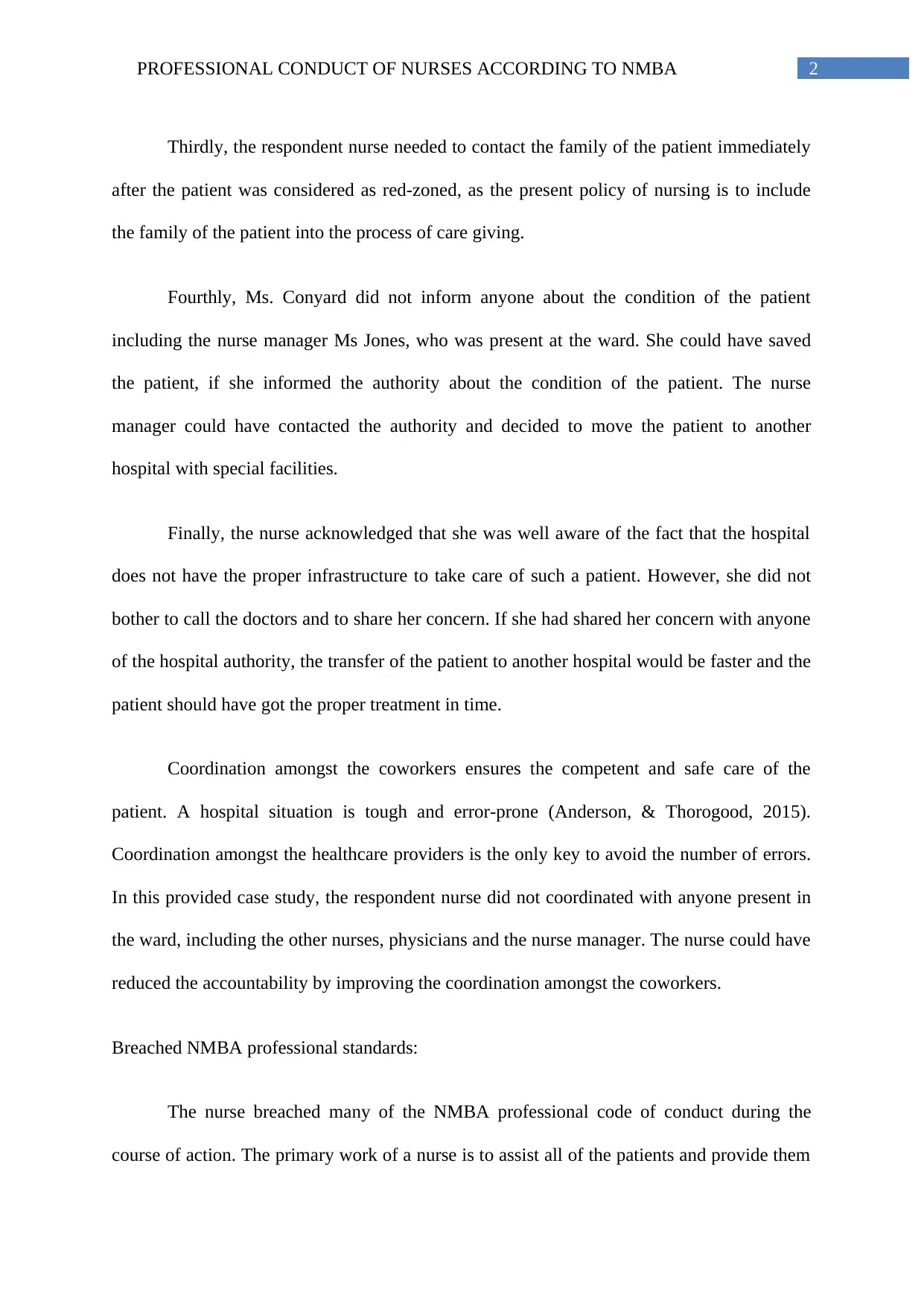
2PROFESSIONAL CONDUCT OF NURSES ACCORDING TO NMBA
Thirdly, the respondent nurse needed to contact the family of the patient immediately
after the patient was considered as red-zoned, as the present policy of nursing is to include
the family of the patient into the process of care giving.
Fourthly, Ms. Conyard did not inform anyone about the condition of the patient
including the nurse manager Ms Jones, who was present at the ward. She could have saved
the patient, if she informed the authority about the condition of the patient. The nurse
manager could have contacted the authority and decided to move the patient to another
hospital with special facilities.
Finally, the nurse acknowledged that she was well aware of the fact that the hospital
does not have the proper infrastructure to take care of such a patient. However, she did not
bother to call the doctors and to share her concern. If she had shared her concern with anyone
of the hospital authority, the transfer of the patient to another hospital would be faster and the
patient should have got the proper treatment in time.
Coordination amongst the coworkers ensures the competent and safe care of the
patient. A hospital situation is tough and error-prone (Anderson, & Thorogood, 2015).
Coordination amongst the healthcare providers is the only key to avoid the number of errors.
In this provided case study, the respondent nurse did not coordinated with anyone present in
the ward, including the other nurses, physicians and the nurse manager. The nurse could have
reduced the accountability by improving the coordination amongst the coworkers.
Breached NMBA professional standards:
The nurse breached many of the NMBA professional code of conduct during the
course of action. The primary work of a nurse is to assist all of the patients and provide them
Thirdly, the respondent nurse needed to contact the family of the patient immediately
after the patient was considered as red-zoned, as the present policy of nursing is to include
the family of the patient into the process of care giving.
Fourthly, Ms. Conyard did not inform anyone about the condition of the patient
including the nurse manager Ms Jones, who was present at the ward. She could have saved
the patient, if she informed the authority about the condition of the patient. The nurse
manager could have contacted the authority and decided to move the patient to another
hospital with special facilities.
Finally, the nurse acknowledged that she was well aware of the fact that the hospital
does not have the proper infrastructure to take care of such a patient. However, she did not
bother to call the doctors and to share her concern. If she had shared her concern with anyone
of the hospital authority, the transfer of the patient to another hospital would be faster and the
patient should have got the proper treatment in time.
Coordination amongst the coworkers ensures the competent and safe care of the
patient. A hospital situation is tough and error-prone (Anderson, & Thorogood, 2015).
Coordination amongst the healthcare providers is the only key to avoid the number of errors.
In this provided case study, the respondent nurse did not coordinated with anyone present in
the ward, including the other nurses, physicians and the nurse manager. The nurse could have
reduced the accountability by improving the coordination amongst the coworkers.
Breached NMBA professional standards:
The nurse breached many of the NMBA professional code of conduct during the
course of action. The primary work of a nurse is to assist all of the patients and provide them
⊘ This is a preview!⊘
Do you want full access?
Subscribe today to unlock all pages.

Trusted by 1+ million students worldwide
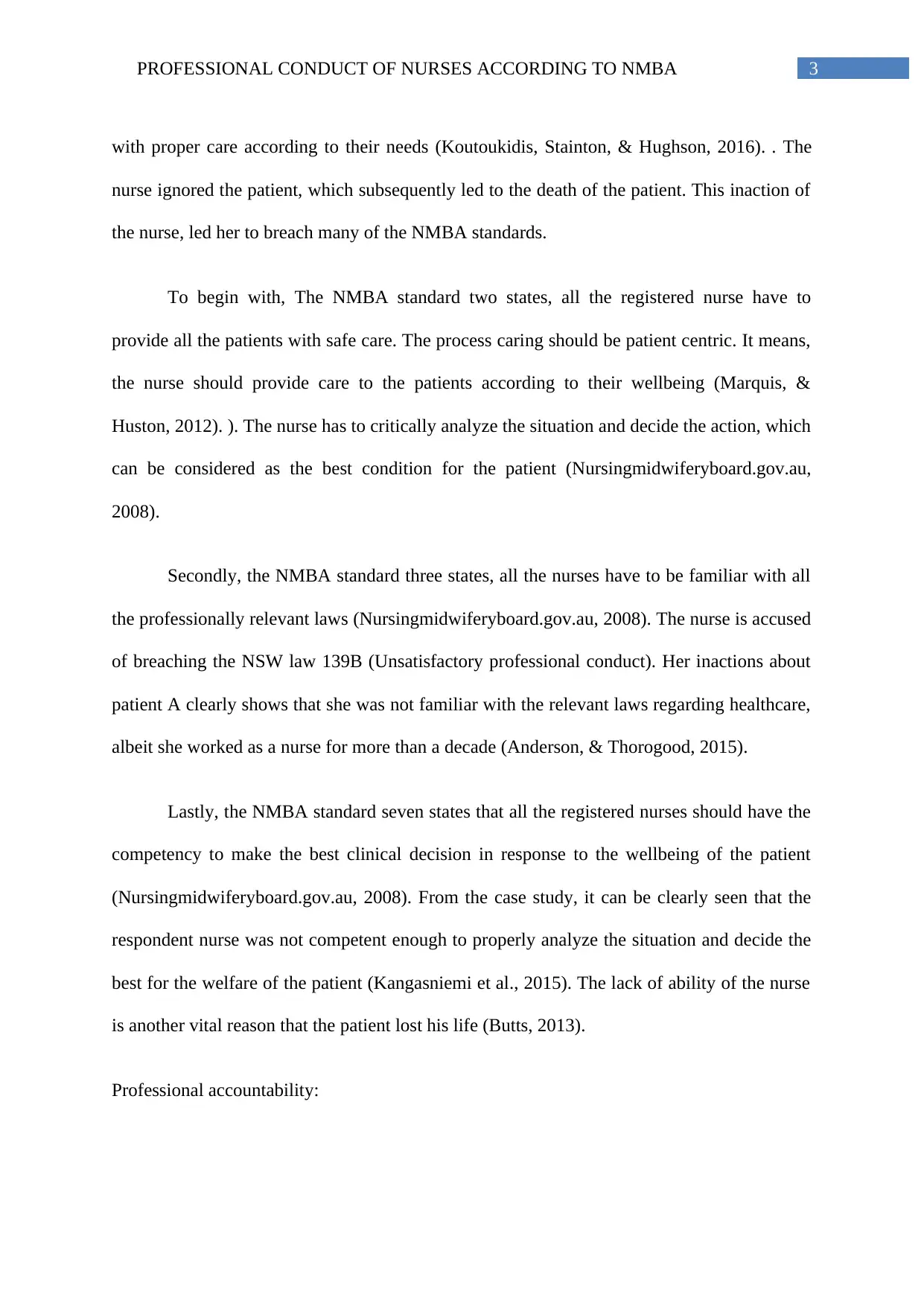
3PROFESSIONAL CONDUCT OF NURSES ACCORDING TO NMBA
with proper care according to their needs (Koutoukidis, Stainton, & Hughson, 2016). . The
nurse ignored the patient, which subsequently led to the death of the patient. This inaction of
the nurse, led her to breach many of the NMBA standards.
To begin with, The NMBA standard two states, all the registered nurse have to
provide all the patients with safe care. The process caring should be patient centric. It means,
the nurse should provide care to the patients according to their wellbeing (Marquis, &
Huston, 2012). ). The nurse has to critically analyze the situation and decide the action, which
can be considered as the best condition for the patient (Nursingmidwiferyboard.gov.au,
2008).
Secondly, the NMBA standard three states, all the nurses have to be familiar with all
the professionally relevant laws (Nursingmidwiferyboard.gov.au, 2008). The nurse is accused
of breaching the NSW law 139B (Unsatisfactory professional conduct). Her inactions about
patient A clearly shows that she was not familiar with the relevant laws regarding healthcare,
albeit she worked as a nurse for more than a decade (Anderson, & Thorogood, 2015).
Lastly, the NMBA standard seven states that all the registered nurses should have the
competency to make the best clinical decision in response to the wellbeing of the patient
(Nursingmidwiferyboard.gov.au, 2008). From the case study, it can be clearly seen that the
respondent nurse was not competent enough to properly analyze the situation and decide the
best for the welfare of the patient (Kangasniemi et al., 2015). The lack of ability of the nurse
is another vital reason that the patient lost his life (Butts, 2013).
Professional accountability:
with proper care according to their needs (Koutoukidis, Stainton, & Hughson, 2016). . The
nurse ignored the patient, which subsequently led to the death of the patient. This inaction of
the nurse, led her to breach many of the NMBA standards.
To begin with, The NMBA standard two states, all the registered nurse have to
provide all the patients with safe care. The process caring should be patient centric. It means,
the nurse should provide care to the patients according to their wellbeing (Marquis, &
Huston, 2012). ). The nurse has to critically analyze the situation and decide the action, which
can be considered as the best condition for the patient (Nursingmidwiferyboard.gov.au,
2008).
Secondly, the NMBA standard three states, all the nurses have to be familiar with all
the professionally relevant laws (Nursingmidwiferyboard.gov.au, 2008). The nurse is accused
of breaching the NSW law 139B (Unsatisfactory professional conduct). Her inactions about
patient A clearly shows that she was not familiar with the relevant laws regarding healthcare,
albeit she worked as a nurse for more than a decade (Anderson, & Thorogood, 2015).
Lastly, the NMBA standard seven states that all the registered nurses should have the
competency to make the best clinical decision in response to the wellbeing of the patient
(Nursingmidwiferyboard.gov.au, 2008). From the case study, it can be clearly seen that the
respondent nurse was not competent enough to properly analyze the situation and decide the
best for the welfare of the patient (Kangasniemi et al., 2015). The lack of ability of the nurse
is another vital reason that the patient lost his life (Butts, 2013).
Professional accountability:
Paraphrase This Document
Need a fresh take? Get an instant paraphrase of this document with our AI Paraphraser
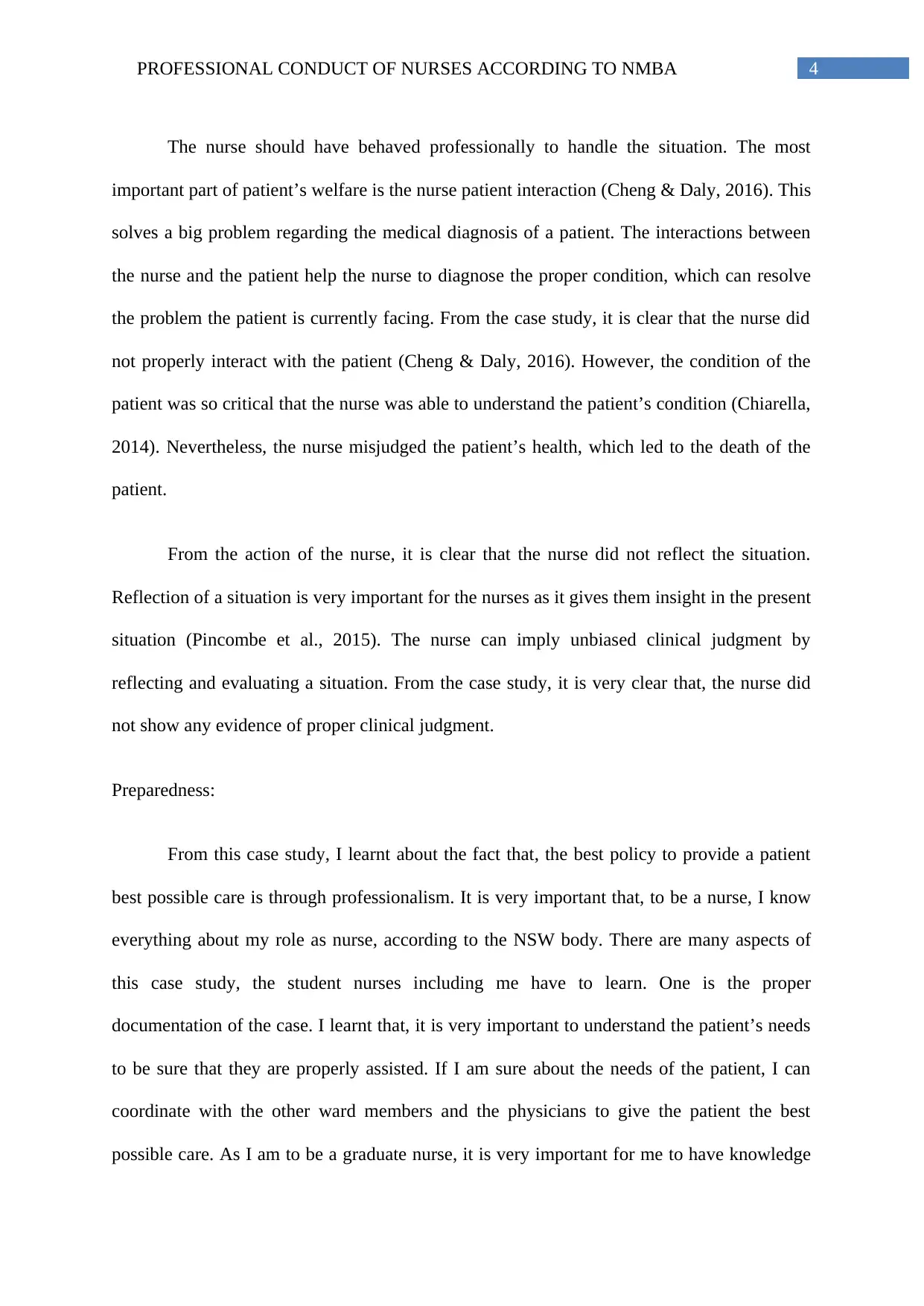
4PROFESSIONAL CONDUCT OF NURSES ACCORDING TO NMBA
The nurse should have behaved professionally to handle the situation. The most
important part of patient’s welfare is the nurse patient interaction (Cheng & Daly, 2016). This
solves a big problem regarding the medical diagnosis of a patient. The interactions between
the nurse and the patient help the nurse to diagnose the proper condition, which can resolve
the problem the patient is currently facing. From the case study, it is clear that the nurse did
not properly interact with the patient (Cheng & Daly, 2016). However, the condition of the
patient was so critical that the nurse was able to understand the patient’s condition (Chiarella,
2014). Nevertheless, the nurse misjudged the patient’s health, which led to the death of the
patient.
From the action of the nurse, it is clear that the nurse did not reflect the situation.
Reflection of a situation is very important for the nurses as it gives them insight in the present
situation (Pincombe et al., 2015). The nurse can imply unbiased clinical judgment by
reflecting and evaluating a situation. From the case study, it is very clear that, the nurse did
not show any evidence of proper clinical judgment.
Preparedness:
From this case study, I learnt about the fact that, the best policy to provide a patient
best possible care is through professionalism. It is very important that, to be a nurse, I know
everything about my role as nurse, according to the NSW body. There are many aspects of
this case study, the student nurses including me have to learn. One is the proper
documentation of the case. I learnt that, it is very important to understand the patient’s needs
to be sure that they are properly assisted. If I am sure about the needs of the patient, I can
coordinate with the other ward members and the physicians to give the patient the best
possible care. As I am to be a graduate nurse, it is very important for me to have knowledge
The nurse should have behaved professionally to handle the situation. The most
important part of patient’s welfare is the nurse patient interaction (Cheng & Daly, 2016). This
solves a big problem regarding the medical diagnosis of a patient. The interactions between
the nurse and the patient help the nurse to diagnose the proper condition, which can resolve
the problem the patient is currently facing. From the case study, it is clear that the nurse did
not properly interact with the patient (Cheng & Daly, 2016). However, the condition of the
patient was so critical that the nurse was able to understand the patient’s condition (Chiarella,
2014). Nevertheless, the nurse misjudged the patient’s health, which led to the death of the
patient.
From the action of the nurse, it is clear that the nurse did not reflect the situation.
Reflection of a situation is very important for the nurses as it gives them insight in the present
situation (Pincombe et al., 2015). The nurse can imply unbiased clinical judgment by
reflecting and evaluating a situation. From the case study, it is very clear that, the nurse did
not show any evidence of proper clinical judgment.
Preparedness:
From this case study, I learnt about the fact that, the best policy to provide a patient
best possible care is through professionalism. It is very important that, to be a nurse, I know
everything about my role as nurse, according to the NSW body. There are many aspects of
this case study, the student nurses including me have to learn. One is the proper
documentation of the case. I learnt that, it is very important to understand the patient’s needs
to be sure that they are properly assisted. If I am sure about the needs of the patient, I can
coordinate with the other ward members and the physicians to give the patient the best
possible care. As I am to be a graduate nurse, it is very important for me to have knowledge
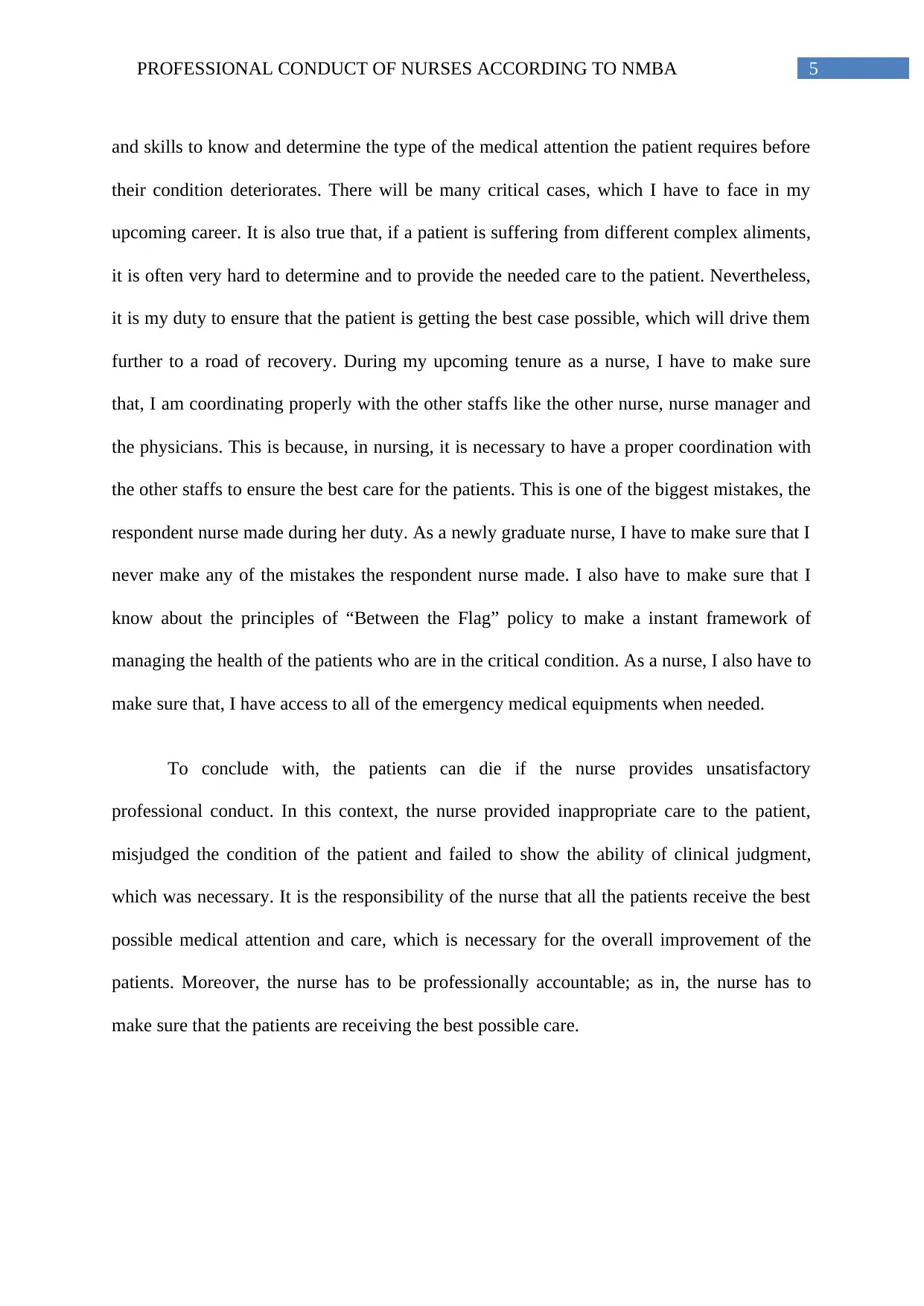
5PROFESSIONAL CONDUCT OF NURSES ACCORDING TO NMBA
and skills to know and determine the type of the medical attention the patient requires before
their condition deteriorates. There will be many critical cases, which I have to face in my
upcoming career. It is also true that, if a patient is suffering from different complex aliments,
it is often very hard to determine and to provide the needed care to the patient. Nevertheless,
it is my duty to ensure that the patient is getting the best case possible, which will drive them
further to a road of recovery. During my upcoming tenure as a nurse, I have to make sure
that, I am coordinating properly with the other staffs like the other nurse, nurse manager and
the physicians. This is because, in nursing, it is necessary to have a proper coordination with
the other staffs to ensure the best care for the patients. This is one of the biggest mistakes, the
respondent nurse made during her duty. As a newly graduate nurse, I have to make sure that I
never make any of the mistakes the respondent nurse made. I also have to make sure that I
know about the principles of “Between the Flag” policy to make a instant framework of
managing the health of the patients who are in the critical condition. As a nurse, I also have to
make sure that, I have access to all of the emergency medical equipments when needed.
To conclude with, the patients can die if the nurse provides unsatisfactory
professional conduct. In this context, the nurse provided inappropriate care to the patient,
misjudged the condition of the patient and failed to show the ability of clinical judgment,
which was necessary. It is the responsibility of the nurse that all the patients receive the best
possible medical attention and care, which is necessary for the overall improvement of the
patients. Moreover, the nurse has to be professionally accountable; as in, the nurse has to
make sure that the patients are receiving the best possible care.
and skills to know and determine the type of the medical attention the patient requires before
their condition deteriorates. There will be many critical cases, which I have to face in my
upcoming career. It is also true that, if a patient is suffering from different complex aliments,
it is often very hard to determine and to provide the needed care to the patient. Nevertheless,
it is my duty to ensure that the patient is getting the best case possible, which will drive them
further to a road of recovery. During my upcoming tenure as a nurse, I have to make sure
that, I am coordinating properly with the other staffs like the other nurse, nurse manager and
the physicians. This is because, in nursing, it is necessary to have a proper coordination with
the other staffs to ensure the best care for the patients. This is one of the biggest mistakes, the
respondent nurse made during her duty. As a newly graduate nurse, I have to make sure that I
never make any of the mistakes the respondent nurse made. I also have to make sure that I
know about the principles of “Between the Flag” policy to make a instant framework of
managing the health of the patients who are in the critical condition. As a nurse, I also have to
make sure that, I have access to all of the emergency medical equipments when needed.
To conclude with, the patients can die if the nurse provides unsatisfactory
professional conduct. In this context, the nurse provided inappropriate care to the patient,
misjudged the condition of the patient and failed to show the ability of clinical judgment,
which was necessary. It is the responsibility of the nurse that all the patients receive the best
possible medical attention and care, which is necessary for the overall improvement of the
patients. Moreover, the nurse has to be professionally accountable; as in, the nurse has to
make sure that the patients are receiving the best possible care.
⊘ This is a preview!⊘
Do you want full access?
Subscribe today to unlock all pages.

Trusted by 1+ million students worldwide
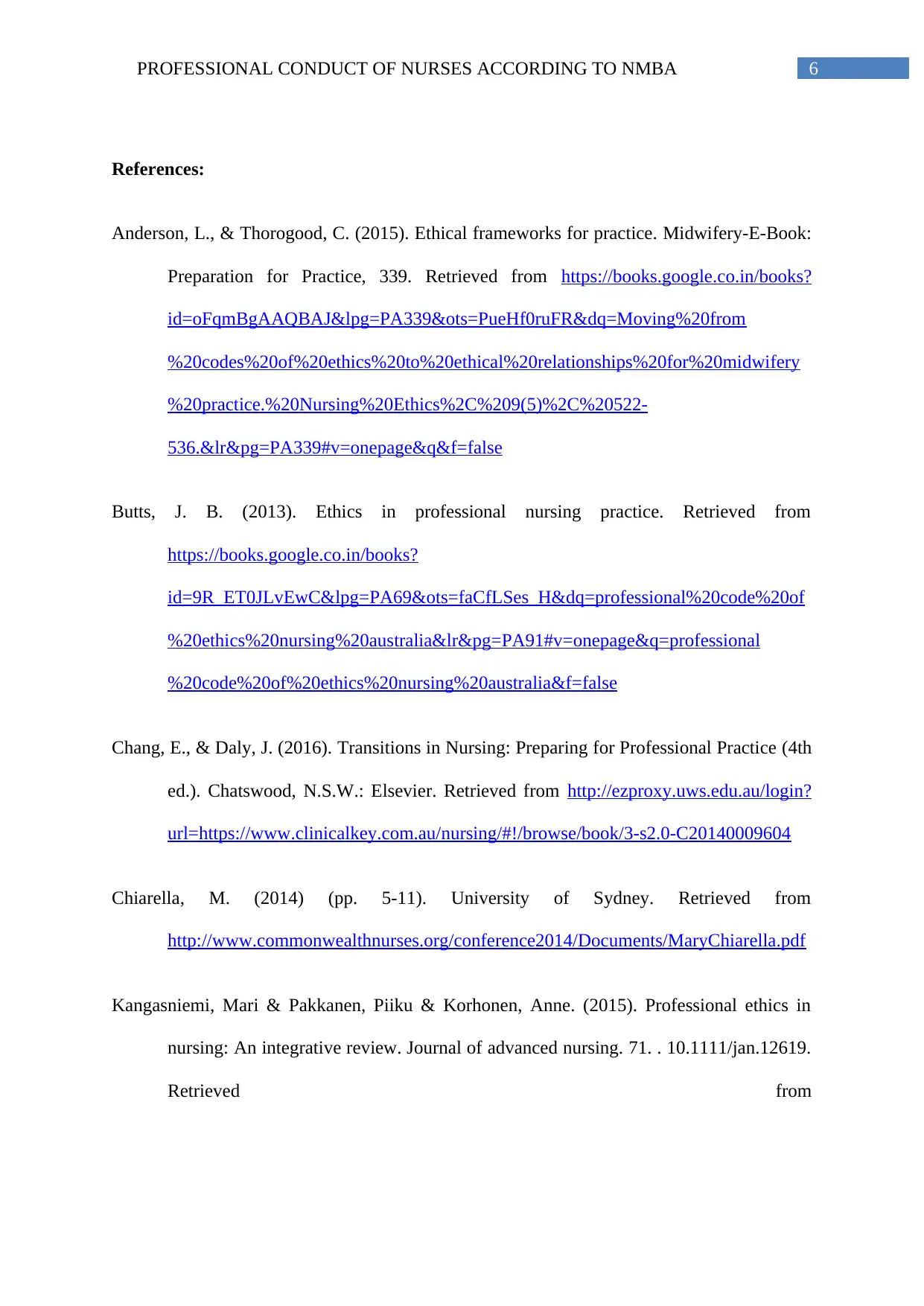
6PROFESSIONAL CONDUCT OF NURSES ACCORDING TO NMBA
References:
Anderson, L., & Thorogood, C. (2015). Ethical frameworks for practice. Midwifery-E-Book:
Preparation for Practice, 339. Retrieved from https://books.google.co.in/books?
id=oFqmBgAAQBAJ&lpg=PA339&ots=PueHf0ruFR&dq=Moving%20from
%20codes%20of%20ethics%20to%20ethical%20relationships%20for%20midwifery
%20practice.%20Nursing%20Ethics%2C%209(5)%2C%20522-
536.&lr&pg=PA339#v=onepage&q&f=false
Butts, J. B. (2013). Ethics in professional nursing practice. Retrieved from
https://books.google.co.in/books?
id=9R_ET0JLvEwC&lpg=PA69&ots=faCfLSes_H&dq=professional%20code%20of
%20ethics%20nursing%20australia&lr&pg=PA91#v=onepage&q=professional
%20code%20of%20ethics%20nursing%20australia&f=false
Chang, E., & Daly, J. (2016). Transitions in Nursing: Preparing for Professional Practice (4th
ed.). Chatswood, N.S.W.: Elsevier. Retrieved from http://ezproxy.uws.edu.au/login?
url=https://www.clinicalkey.com.au/nursing/#!/browse/book/3-s2.0-C20140009604
Chiarella, M. (2014) (pp. 5-11). University of Sydney. Retrieved from
http://www.commonwealthnurses.org/conference2014/Documents/MaryChiarella.pdf
Kangasniemi, Mari & Pakkanen, Piiku & Korhonen, Anne. (2015). Professional ethics in
nursing: An integrative review. Journal of advanced nursing. 71. . 10.1111/jan.12619.
Retrieved from
References:
Anderson, L., & Thorogood, C. (2015). Ethical frameworks for practice. Midwifery-E-Book:
Preparation for Practice, 339. Retrieved from https://books.google.co.in/books?
id=oFqmBgAAQBAJ&lpg=PA339&ots=PueHf0ruFR&dq=Moving%20from
%20codes%20of%20ethics%20to%20ethical%20relationships%20for%20midwifery
%20practice.%20Nursing%20Ethics%2C%209(5)%2C%20522-
536.&lr&pg=PA339#v=onepage&q&f=false
Butts, J. B. (2013). Ethics in professional nursing practice. Retrieved from
https://books.google.co.in/books?
id=9R_ET0JLvEwC&lpg=PA69&ots=faCfLSes_H&dq=professional%20code%20of
%20ethics%20nursing%20australia&lr&pg=PA91#v=onepage&q=professional
%20code%20of%20ethics%20nursing%20australia&f=false
Chang, E., & Daly, J. (2016). Transitions in Nursing: Preparing for Professional Practice (4th
ed.). Chatswood, N.S.W.: Elsevier. Retrieved from http://ezproxy.uws.edu.au/login?
url=https://www.clinicalkey.com.au/nursing/#!/browse/book/3-s2.0-C20140009604
Chiarella, M. (2014) (pp. 5-11). University of Sydney. Retrieved from
http://www.commonwealthnurses.org/conference2014/Documents/MaryChiarella.pdf
Kangasniemi, Mari & Pakkanen, Piiku & Korhonen, Anne. (2015). Professional ethics in
nursing: An integrative review. Journal of advanced nursing. 71. . 10.1111/jan.12619.
Retrieved from
Paraphrase This Document
Need a fresh take? Get an instant paraphrase of this document with our AI Paraphraser
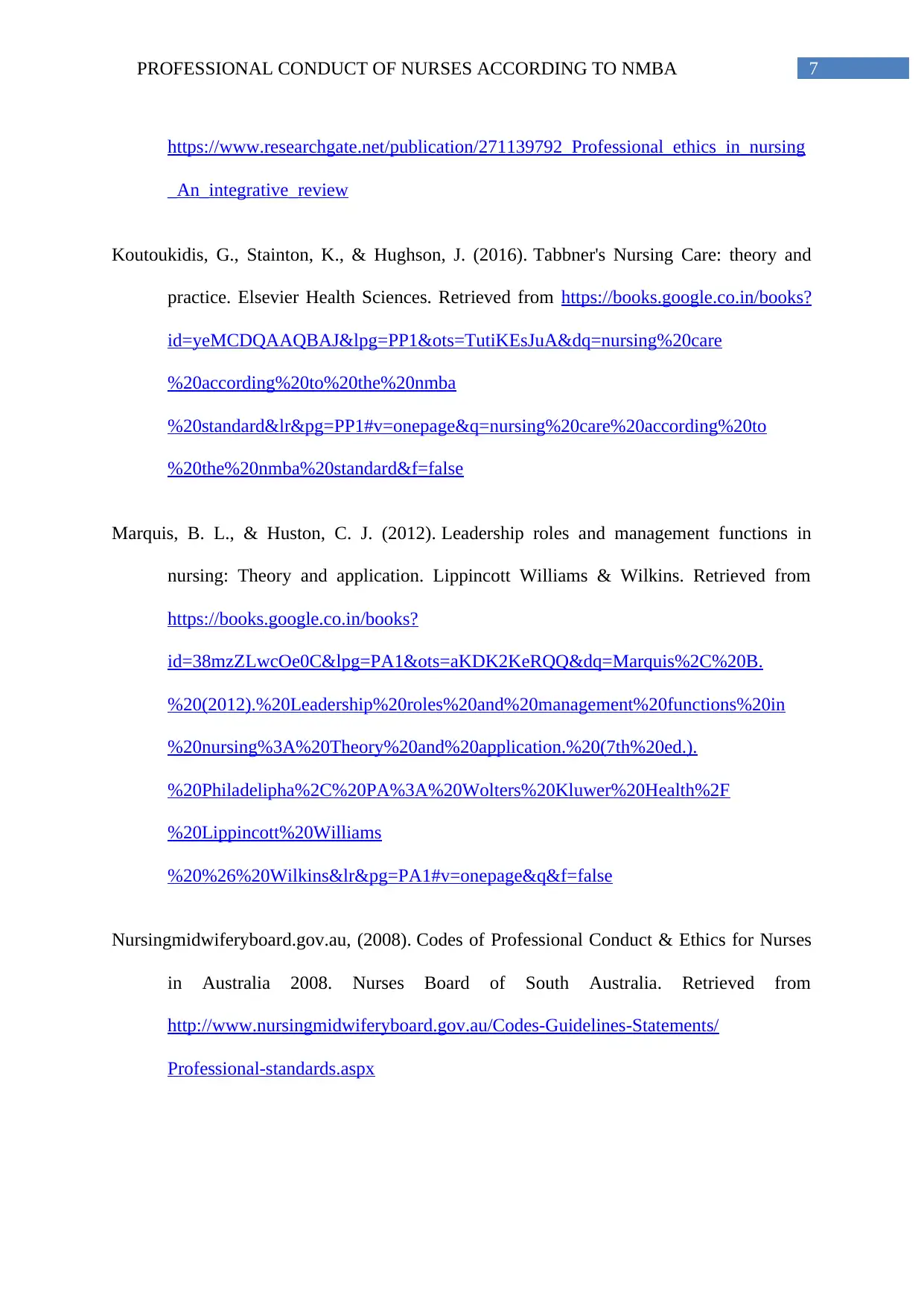
7PROFESSIONAL CONDUCT OF NURSES ACCORDING TO NMBA
https://www.researchgate.net/publication/271139792_Professional_ethics_in_nursing
_An_integrative_review
Koutoukidis, G., Stainton, K., & Hughson, J. (2016). Tabbner's Nursing Care: theory and
practice. Elsevier Health Sciences. Retrieved from https://books.google.co.in/books?
id=yeMCDQAAQBAJ&lpg=PP1&ots=TutiKEsJuA&dq=nursing%20care
%20according%20to%20the%20nmba
%20standard&lr&pg=PP1#v=onepage&q=nursing%20care%20according%20to
%20the%20nmba%20standard&f=false
Marquis, B. L., & Huston, C. J. (2012). Leadership roles and management functions in
nursing: Theory and application. Lippincott Williams & Wilkins. Retrieved from
https://books.google.co.in/books?
id=38mzZLwcOe0C&lpg=PA1&ots=aKDK2KeRQQ&dq=Marquis%2C%20B.
%20(2012).%20Leadership%20roles%20and%20management%20functions%20in
%20nursing%3A%20Theory%20and%20application.%20(7th%20ed.).
%20Philadelipha%2C%20PA%3A%20Wolters%20Kluwer%20Health%2F
%20Lippincott%20Williams
%20%26%20Wilkins&lr&pg=PA1#v=onepage&q&f=false
Nursingmidwiferyboard.gov.au, (2008). Codes of Professional Conduct & Ethics for Nurses
in Australia 2008. Nurses Board of South Australia. Retrieved from
http://www.nursingmidwiferyboard.gov.au/Codes-Guidelines-Statements/
Professional-standards.aspx
https://www.researchgate.net/publication/271139792_Professional_ethics_in_nursing
_An_integrative_review
Koutoukidis, G., Stainton, K., & Hughson, J. (2016). Tabbner's Nursing Care: theory and
practice. Elsevier Health Sciences. Retrieved from https://books.google.co.in/books?
id=yeMCDQAAQBAJ&lpg=PP1&ots=TutiKEsJuA&dq=nursing%20care
%20according%20to%20the%20nmba
%20standard&lr&pg=PP1#v=onepage&q=nursing%20care%20according%20to
%20the%20nmba%20standard&f=false
Marquis, B. L., & Huston, C. J. (2012). Leadership roles and management functions in
nursing: Theory and application. Lippincott Williams & Wilkins. Retrieved from
https://books.google.co.in/books?
id=38mzZLwcOe0C&lpg=PA1&ots=aKDK2KeRQQ&dq=Marquis%2C%20B.
%20(2012).%20Leadership%20roles%20and%20management%20functions%20in
%20nursing%3A%20Theory%20and%20application.%20(7th%20ed.).
%20Philadelipha%2C%20PA%3A%20Wolters%20Kluwer%20Health%2F
%20Lippincott%20Williams
%20%26%20Wilkins&lr&pg=PA1#v=onepage&q&f=false
Nursingmidwiferyboard.gov.au, (2008). Codes of Professional Conduct & Ethics for Nurses
in Australia 2008. Nurses Board of South Australia. Retrieved from
http://www.nursingmidwiferyboard.gov.au/Codes-Guidelines-Statements/
Professional-standards.aspx
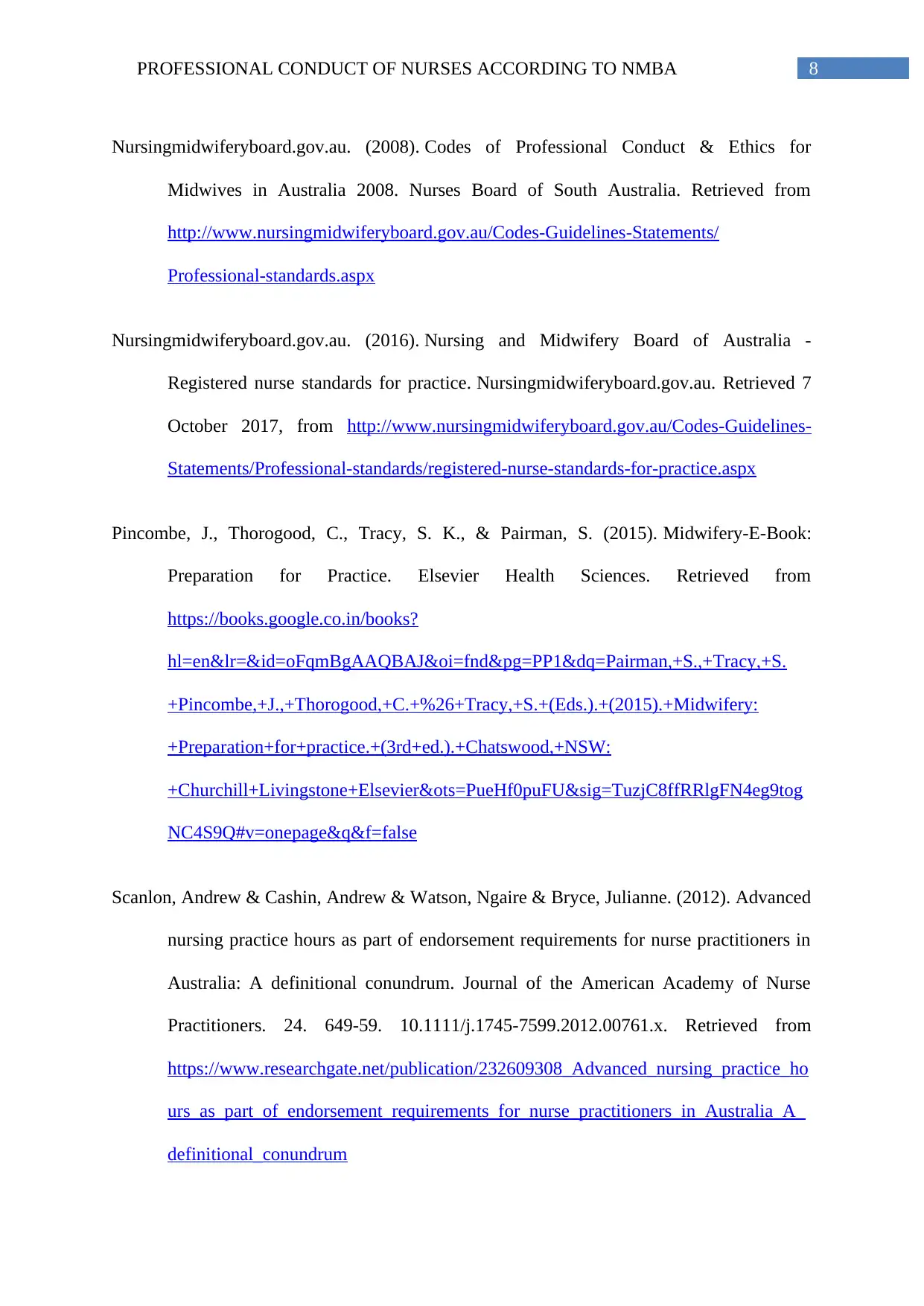
8PROFESSIONAL CONDUCT OF NURSES ACCORDING TO NMBA
Nursingmidwiferyboard.gov.au. (2008). Codes of Professional Conduct & Ethics for
Midwives in Australia 2008. Nurses Board of South Australia. Retrieved from
http://www.nursingmidwiferyboard.gov.au/Codes-Guidelines-Statements/
Professional-standards.aspx
Nursingmidwiferyboard.gov.au. (2016). Nursing and Midwifery Board of Australia -
Registered nurse standards for practice. Nursingmidwiferyboard.gov.au. Retrieved 7
October 2017, from http://www.nursingmidwiferyboard.gov.au/Codes-Guidelines-
Statements/Professional-standards/registered-nurse-standards-for-practice.aspx
Pincombe, J., Thorogood, C., Tracy, S. K., & Pairman, S. (2015). Midwifery-E-Book:
Preparation for Practice. Elsevier Health Sciences. Retrieved from
https://books.google.co.in/books?
hl=en&lr=&id=oFqmBgAAQBAJ&oi=fnd&pg=PP1&dq=Pairman,+S.,+Tracy,+S.
+Pincombe,+J.,+Thorogood,+C.+%26+Tracy,+S.+(Eds.).+(2015).+Midwifery:
+Preparation+for+practice.+(3rd+ed.).+Chatswood,+NSW:
+Churchill+Livingstone+Elsevier&ots=PueHf0puFU&sig=TuzjC8ffRRlgFN4eg9tog
NC4S9Q#v=onepage&q&f=false
Scanlon, Andrew & Cashin, Andrew & Watson, Ngaire & Bryce, Julianne. (2012). Advanced
nursing practice hours as part of endorsement requirements for nurse practitioners in
Australia: A definitional conundrum. Journal of the American Academy of Nurse
Practitioners. 24. 649-59. 10.1111/j.1745-7599.2012.00761.x. Retrieved from
https://www.researchgate.net/publication/232609308_Advanced_nursing_practice_ho
urs_as_part_of_endorsement_requirements_for_nurse_practitioners_in_Australia_A_
definitional_conundrum
Nursingmidwiferyboard.gov.au. (2008). Codes of Professional Conduct & Ethics for
Midwives in Australia 2008. Nurses Board of South Australia. Retrieved from
http://www.nursingmidwiferyboard.gov.au/Codes-Guidelines-Statements/
Professional-standards.aspx
Nursingmidwiferyboard.gov.au. (2016). Nursing and Midwifery Board of Australia -
Registered nurse standards for practice. Nursingmidwiferyboard.gov.au. Retrieved 7
October 2017, from http://www.nursingmidwiferyboard.gov.au/Codes-Guidelines-
Statements/Professional-standards/registered-nurse-standards-for-practice.aspx
Pincombe, J., Thorogood, C., Tracy, S. K., & Pairman, S. (2015). Midwifery-E-Book:
Preparation for Practice. Elsevier Health Sciences. Retrieved from
https://books.google.co.in/books?
hl=en&lr=&id=oFqmBgAAQBAJ&oi=fnd&pg=PP1&dq=Pairman,+S.,+Tracy,+S.
+Pincombe,+J.,+Thorogood,+C.+%26+Tracy,+S.+(Eds.).+(2015).+Midwifery:
+Preparation+for+practice.+(3rd+ed.).+Chatswood,+NSW:
+Churchill+Livingstone+Elsevier&ots=PueHf0puFU&sig=TuzjC8ffRRlgFN4eg9tog
NC4S9Q#v=onepage&q&f=false
Scanlon, Andrew & Cashin, Andrew & Watson, Ngaire & Bryce, Julianne. (2012). Advanced
nursing practice hours as part of endorsement requirements for nurse practitioners in
Australia: A definitional conundrum. Journal of the American Academy of Nurse
Practitioners. 24. 649-59. 10.1111/j.1745-7599.2012.00761.x. Retrieved from
https://www.researchgate.net/publication/232609308_Advanced_nursing_practice_ho
urs_as_part_of_endorsement_requirements_for_nurse_practitioners_in_Australia_A_
definitional_conundrum
⊘ This is a preview!⊘
Do you want full access?
Subscribe today to unlock all pages.

Trusted by 1+ million students worldwide
1 out of 9
Related Documents
Your All-in-One AI-Powered Toolkit for Academic Success.
+13062052269
info@desklib.com
Available 24*7 on WhatsApp / Email
![[object Object]](/_next/static/media/star-bottom.7253800d.svg)
Unlock your academic potential
Copyright © 2020–2025 A2Z Services. All Rights Reserved. Developed and managed by ZUCOL.





